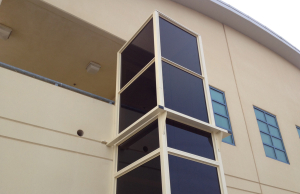Where Should You Install a Wheelchair Lift?
Home » Where Should You Install a Wheelchair Lift?
Any homeowner or building owner goes through the following dilemma when considering accessibility solutions: Should I add a wheelchair lift or a ramp?
At face value, the ramp seems like a better deal: It’s less costly and likely to be used by more people. However, for multiple reasons, wheelchair lifts, in terms of space, turn out to be more versatile and compact.

Contact Us for a Quote Today: 888-227-3858
Where You’d Install a Ramp
What’s the biggest difference between a wheelchair lift and a ramp? The amount of space it takes up. As a general rule, a ramp must cover one foot horizontally for every inch off the ground. As a result, when you’re providing accessibility for one foot of vertical distance, a ramp must be 12 feet long.
Yet, not every home or business has this type of space. Furthermore, ramps come with a few safety issues:
- Wheelchair users and others with mobility issues have to exert greater strength to ascend the incline.
- If the ramp is outdoors, the risk of snow and ice gathering on the surface remains and must be addressed. Otherwise, you’re creating a slip hazard for all users.
Stairways
For many buildings, particularly those no more than three stories high, stairs remain the only pathway from one floor to another. This scenario creates a significant obstruction for wheelchair users, and as the building isn’t equipped with an elevator, this creates a situation that doesn’t comply with ADA recommendations.
As an alternative, wheelchair lifts expand mobility options and meet the ADA’s standards. When dealing with stairways, you have two options:
- An inclined platform lift, with a track aligned with the staircase’s perimeter.
- A vertical platform lift, which travels up a hoistway from one floor to another.
Nearly Anywhere
When enclosed vertical platform lifts are considered, these can be installed nearly anywhere, as the building or home needs minimal modifications. This entirely self-contained fixture features a drive mast, a passenger platform, and an aluminum or glass enclosure.
As you’re exploring mobility solutions, get Apex Wheelchair Lifts involved. Contact us to learn more about inclined and vertical platform lifts.
OUR PRODUCTS
About Our Products
- Electric Wheelchair Lifts
- Handicapped Wheelchair Lift
- Handicapped Wheelchair Lifts
- Handicap Wheelchair Lift
- Handicap Wheelchair Lifts
- Home Wheelchair Lift
- Home Wheelchair Lifts
- Lifts for Wheelchairs
- Outdoor Wheelchair Lifts
- Platform Lifts
- Platform Wheelchair Lift
- Platform Wheelchair Lifts
- Power Wheelchair Lifts
- Wheelchair Lift
- Wheelchair Lifts
- Wheelchair Lifts for Stairs
- Wheelchair Lift Cost
- Wheel Chair Lift
- Wheel Chair Lifts
- Wheelchair Stair Lift
- Wheel Chair Stair Lift
Tips and Information
- A Wheelchair Lift or Ramp?: The Pros and Cons
- All You Need to Know About Vertical Wheelchair Lifts
- Can An Inclined Wheelchair Lift Work in a Home?
- Cleaning a Wheelchair Lift
- Designing a Custom Wheelchair Lift
- Differences between Vertical and Inclined Wheelchair Lifts
- Different Types of Wheelchair Lifts
- Does a Wheelchair Lift Work Outdoors?
- Do You Need a Multi-Story Wheelchair Lift?
- Finding the Right Inclined Wheelchair Lift
- Five Tips for Installing Inclined and Vertical Wheelchair Lifts
- Getting the Most Out of Your Wheelchair Lift
- Guidelines for Vertical Platform Lifts
- How Are Curved Platform Lifts Designed?
- How a Wheelchair Lift Benefits a Small Business
- How Does a Curved Platform Lift Work?
- How Does a Platform Wheelchair Lift Work?
- How Does an Inclined Platform Lift Operate?
- How Far Can a Wheelchair Lift Travel?
- How Fast Can a Wheelchair Lift Travel?
- How is a Custom Wheelchair Lift Created?
- How is a Wheelchair Lift Installed?
- How Much Does a Wheelchair Lift Cost?
- How to be ADA Compliant With a Wheelchair Lift
- How to Incorporate Wheelchair Lifts into a Multistory Building
- How to Maintain a Wheelchair Lift
- Installing an Outdoor Wheelchair Lift
- Insurance for Wheelchair Lifts and Stair Lifts
- Is an Inclined or Vertical Wheelchair Lift Better for your Building?
- Maintaining a Safe Wheelchair Lift
- Operating a Wheelchair lift
- Places for Installing a Wheelchair Lift in Homes & Commercial Areas
- Preparing Your Home for a Wheelchair Lift
- Safety Features for Wheelchair Lifts
- Safety Tips for Using Wheelchair Lifts
- Standard Wheelchair Lift Features
- The Business Benefits of Wheelchair Lifts
- The 9 Key Components of a Vertical Platform Lift
- The Most Important ADA Regulations for Platform Lifts
- The Travel Distances of a Wheelchair Lift
- The Wheelchair Lift Installation Process
- Three Tips for Selecting a Vertical Wheelchair Lift
- Tips for Businesses Accommodating Individuals with Disabilities
- Tips for Installing a Vertical Wheelchair Lift
- Understanding a Hydraulic Wheelchair Lift
- Using a Wheelchair Lift to Transport Heavy Items
- What’s the Difference between a Screw Drive and a Hydraulic Drive?
- What Are the Advantages of the Apex Complete Wheelchair Lift?
- What are the Basic Parts of a Vertical Wheelchair Lift?
- What Are the Wheelchair Lift Options for a Smaller Home?
- What a Business Needs to Know before Installing a Wheelchair Lift
- What is a Multi-level Inclined Wheelchair Lift?
- What Powers an Inclined Wheelchair Lift?
- Wheelchair Lift Costs
- Wheelchair Lift Inspections
- Wheelchair Lifts & Safety
- Why A Wheelchair Lift?
- Wheel Chair Lifts for Curved Staircases
- When does a Commercial Building need a Wheelchair Lift?
- Where Should You Install a Wheelchair Lift?
- Will a Wheelchair Lift Change Your Business Insurance?
- Will a Wheelchair Lift Work for a Small Business?
- Will Your Home Support a Wheelchair Lift?
